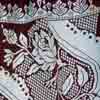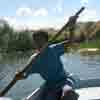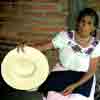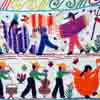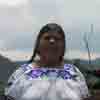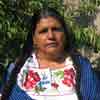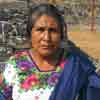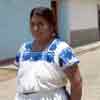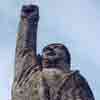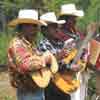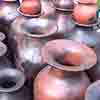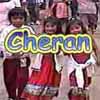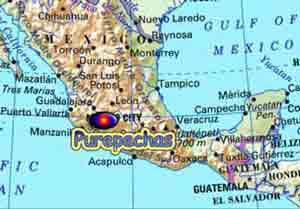|
|
The Purhépechas of the Lake Patzcuaro region all wear similar dress, similar but different. The traditional clothing consists of a embroidered slip, pleated skirt of synthetic material, one or two back strap woven belts, an embroidered blouse, over blouse, reboso and delantal (apron). The blouses are sometimes worn without the over blouse and the more heavily embroidered delantals are worn on special occasions. These delantals are cross stitched and some take as long as three months to embroiderer. The embroidered blouse is generally a floral pattern but geometric designs can also be seen. The lake perimeter is about 60 miles and most village are traditional or in transition. In each of the galleries to the left you will see some stunning scenery and embroidery.
Click here to see a typical costume.
The Purepecha live in the lake and mountain regions of the State of Michoacan, they called them selves "p'urhépecha". When the Spanish conquered these peoples, they imposed the name Tarascan and it was not until recently that the Purepecha were able to get their name back.
The Purepecha region covers about 6000 sq kilometer in the center of the state . It is traditionally divided into tour regions: Japóndarhu (place of the Lake), Eráxamani (Can, Juátarisi (Meseta), lyon of Eleven Pueblos, Zacapu.
The population is concentratedin 22 municipalites: Coeneo, Charapan, Cherán, Chilchota, Erongarícuaro, Los Reyes, Nahuatzen, Nuevo Parangaricutiro, Paracho, Pátzcuaro, Periban, Quiroga, Tancítaro, Tangamandapio, Tangancícuaro, Tingambato, Tinguindín, Tocumbo, Tzintzuntzan, Uruapan, Zacapu y Ziracuaretiro; nether the less, Purepecha speakers are concentrated in 95 of the 113 municipalities of the State.
The present group p'urhépecha comes from a mixture of Chichimecas, Nahua and pre-tarascos that inhabited the shores and islands of the Lake of Patzcuaro at the end of century XII. P'urhépecha-uanacaze kingdom started in in Tzintzuntzan, Ihuatzio and Pátzcuaro from here they began to extend their domination to the region of the Balsas river, Jalisco, Colima, Zacatula and Guanajuato; in the east they were allied to Matlatzincas in order to fight against the Mexicas. The Mexicas ( Aztecs) tried to conquer them and there were great battles in the first half of XV century between the mexicas (Aztecs) and p'urhépechas, however the p'urhé ( Purepecha) were never was conquored. In prehispanic cultural achievements the Purepecha used copper agricultural tools, exceptional in Mesoamerican area. There was a social stratification in which a hierarchy existed starting with the king, cazonci or irécha, followed the knights then the priests, at the base of the pyramid were communities of farmers and fishermen, craftsmen and merchants.
The purhé language has no commonality with other Mesoamerican languages and therefore stands alone as its on family. There are three known dialects the Lake Region, central and mountain. Seventy-five percent are bi-lingual Purepecha / Spanish and 25% speak Purepecha. There are newspapers that print in Purepecha and radio station that transmit in the native language.
There has been a massive immigration to the US from Michoacan as in many other indigenous regions of Mexico. This immigration is so common that in some areas there are not enough workers for full agricultural production. Many towns are now receiving long over due attention.
There are is a great deal of variation between villages in the actual dress that is worn. Although on the surface it seems very similar, the local population easily distinguishes the variety. When visiting the region the apron is the most obvious, however there are slips and blouses worn underneath a heavy over blouse, skirt, and apron that are often embroidered. The back strap woven belts are an important part and in many areas two belts are used.
|
|
|
|




